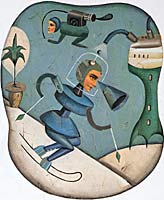Ski Life: FutureSki

Essayist E.B. White saw the future as “a mince pie, long in the baking and never done.” As skiing continues to bake, perched today on the millennium’s edge, skiers can view the first 100 years of their young sport while also catching glimpses into its next millennium.
For the U.S., it all started in 1934 at Gilbert’s Hill in Woodstock, Vt., when a former Dartmouth skier constructed the nation’s first rope-tow and charged $1 a day. Two years later, inspired by a cargo boat’s banana hoist, crews built this country’s first chairlift in Sun Valley, Idaho. Skiing’s future will be built on insights and inspirations such as those found on a banana barge decades ago.
Will skiers schuss under mountain-hugging snowdomes in 2999 and return to the summit by jet packs? Will giant snow-generators blow powder in their paths, much like rose petals cast before a bride? There is only one certainty: the pace of change in skiing will be faster in the future than it has been in the past.
“Your self-adjusting equipment will know everything about you to help you perform¿not just height and weight and your skill level, but critical internal angles of your body,” says Jackson Hogen, director of product development for Head USA. He predicts “constant info feedback” as telemetry flows between skier and ski.
As more people are freed from working in an office and can move to the mountains, “the pressure will grow to balance the needs of a community with the needs of a resort’s infrastructure,” says Bill Jensen, Vail’s chief operating officer. And with “guests’ demands only increasing, there will be a reduction in venues when those without deep pockets drop out,” he says.
Picabo Street, two-time Olympic medalist, sees competitive racing reverting to a purist position, and outlawing technological innovations. Today’s gear “already has the men out-skiing the terrain,” Street says. “Soon, the athletes are going to out-ski any course that’s put in their way.” Race governing bodies will be forced to maintain strict controls over equipment, she predicts.
Along with change, perhaps there is a second sure prediction about skiing’s next millennium: What matters most about skiing is what has changed the least over the ages¿and what will change the least in the future. It’s the magic at the heart of the game.
It’s what caused 19-year-old Toni Matt to tuck the Headwall at Tuckerman Ravine, N.H., in 1939, a feat not since duplicated. It’s what caused U.S. downhiller Andy Mill to pack his injured leg in snow to dull the pain before his heroic 1976 Olympic run. And it’s what will cause some 12-year-old boy to sneak out of his house tonight so he can launch a few jumps off the backyard kicker he’ll build quietly under the bright winter stars.